| Pages:
1
2 |
aga
Forum Drunkard
    
Posts: 7030
Registered: 25-3-2014
Member Is Offline
|
|
DIY Lab Jack
Here's my newer-than-brand-new new lab jack.
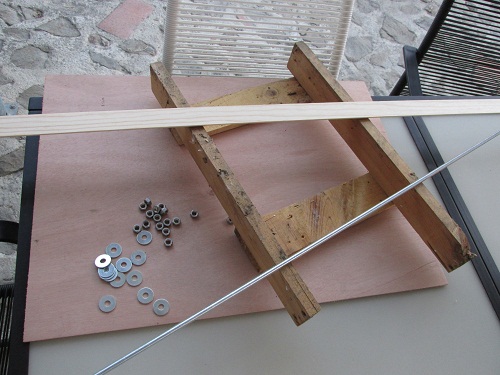
Admittedly it is not currently configured correctly, but that is about to change.
The plywood sheet is new, as is the 8mm threaded bar and the flat wood strip.
Total cost €8.
Best get 'configuring' it ...
|
|
|
Praxichys
International Hazard
    
Posts: 1063
Registered: 31-7-2013
Location: Detroit, Michigan, USA
Member Is Offline
Mood: Coprecipitated
|
|
I'm interested to see how this turns out. Have you thought about putting Formica or at least a thick coating of lacquer on the top surface to prevent
it from getting beat up, burned, or dissolved?
|
|
|
aga
Forum Drunkard
    
Posts: 7030
Registered: 25-3-2014
Member Is Offline
|
|
I was just gonna paint it Blue cos i got some blue paint.
Best see if it works out first, before adding any finishing touches !
Build happening in real time, so maybe some more photos soon.
|
|
|
aga
Forum Drunkard
    
Posts: 7030
Registered: 25-3-2014
Member Is Offline
|
|
A bit of sweatiness and you can guess where it goes from here.
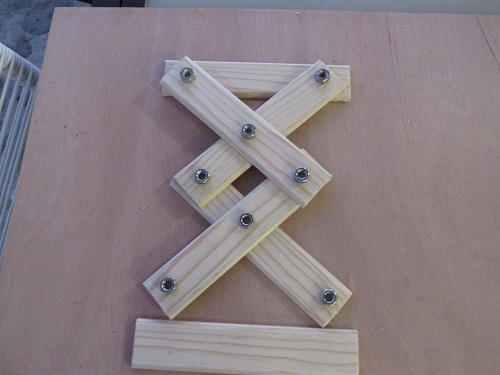 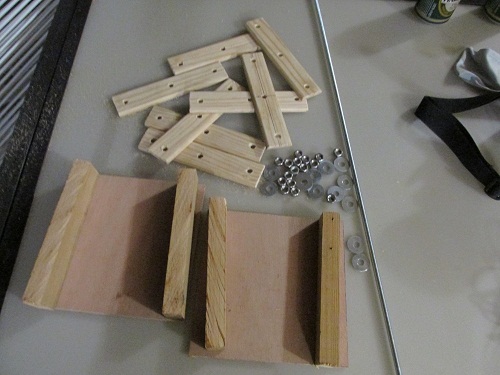
|
|
|
ficolas
Hazard to Others
  
Posts: 146
Registered: 14-5-2016
Member Is Offline
Mood: No Mood
|
|
Quote: Originally posted by Praxichys  | | I'm interested to see how this turns out. Have you thought about putting Formica or at least a thick coating of lacquer on the top surface to prevent
it from getting beat up, burned, or dissolved? |
Formica looks quite expensive, 50€ for a 4x8 feet (1.2x2.4m, had to look that up)
But maybe im looking at something that isnt what I should be looking at.
I had the idea of using teflon coating for my stirr plate, however I cant even find the price online, and I dont know if it would work, it seems like
it should, chemical resistance, up to 260C of heat, and other teflon goodies.
But... I dont know where to get it and at what price. And I dont even know if that can be used in wood...
[Edited on 30-6-2016 by ficolas]
|
|
|
aga
Forum Drunkard
    
Posts: 7030
Registered: 25-3-2014
Member Is Offline
|
|
Well, it kinda works pretty well.
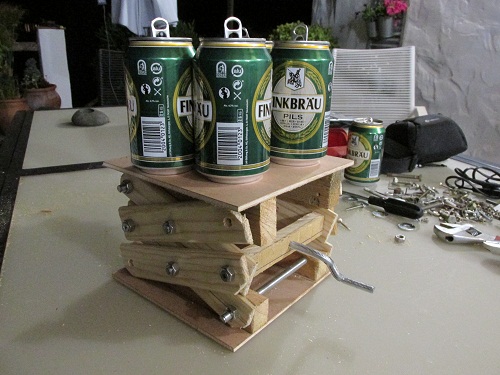 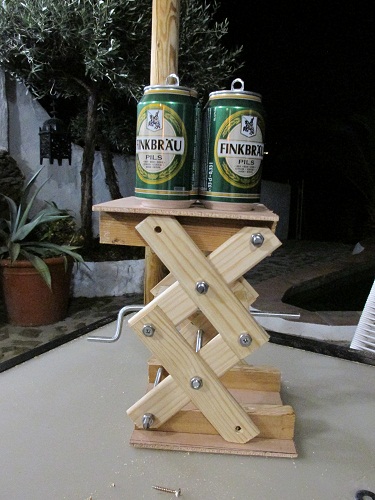
The crank shaft needs one side washered and a nut fixed in place on the other side.
Apart from that, there's a cheapo DIY lab jack.
8 euros, 2.5 hours and 6 beers is all it takes.
Yes, i know i got the top part backwards : this was just a proof-of-drunkeness project.
[Edited on 30-6-2016 by aga]
|
|
|
CharlieA
National Hazard
   
Posts: 645
Registered: 11-8-2015
Location: Missouri, USA
Member Is Offline
Mood: No Mood
|
|
That's very neat, aga... but I think that you have to include the cost of the beer in the cost of the project. Well actually, I guess a CPA would
include the cost of the beer; a chemist would just treat beer cost as a miscellaneous overhead cost!   
|
|
|
j_sum1
Administrator
       
Posts: 6219
Registered: 4-10-2014
Location: Unmoved
Member Is Offline
Mood: Organised
|
|
Nice work aga.
You have already seen this, but here is my efforts. $0, 25 minutes and no beers.
https://www.sciencemadness.org/whisper/viewthread.php?tid=61...
|
|
|
careysub
International Hazard
    
Posts: 1339
Registered: 4-8-2014
Location: Coastal Sage Scrub Biome
Member Is Offline
Mood: Lowest quantum state
|
|
Be sure to varnish it, otherwise it will be impossible to clean (I recommend a urethane coating).
|
|
|
Arg0nAddict
Hazard to Self
 
Posts: 54
Registered: 8-6-2016
Location: PNW
Member Is Offline
Mood: Mercuric
|
|
Awesome! I saved about 1000+ galvanized "Popsicle stick" looking drops from a punch press. Ive had them for years and now know what to build with
them! Thanks!!
|
|
|
aga
Forum Drunkard
    
Posts: 7030
Registered: 25-3-2014
Member Is Offline
|
|
Finished, apart from painting etc. It's surprisingly strong !
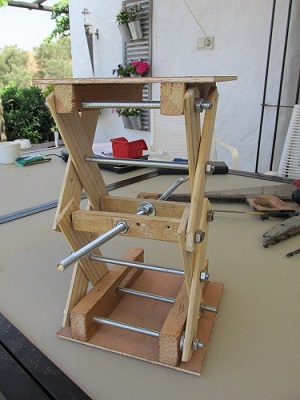 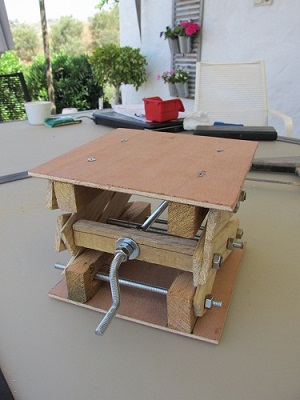
The top has been put on the right way round and a slot cut to hold the moving bottom legs (it could tip over before).
Fully extended it reaches 305mm. Collapsed height = 135mm giving a 170mm travel (=17 cm or 6.7").
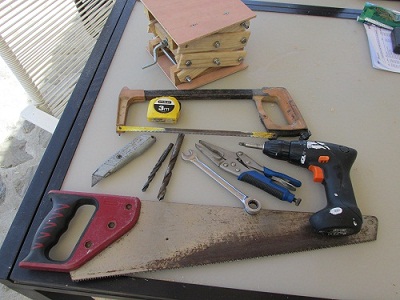
These are all the tools required, although a pillar drill and a bench vice help a lot.
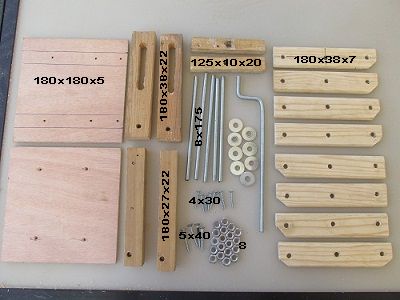
The crank shaft is just some of the 8mm threaded bar bent into shape with a vice.
The 8 flat strips should have a smaller hole drilled in the end without the corner cut off. All the other holes are 8mm.
More or less nuts can be used depending on how tight you want the whole thing.
A cordless screwdriver can attach to the straight end of the crank shaft, instantly converting it to a motorised jack !
|
|
|
careysub
International Hazard
    
Posts: 1339
Registered: 4-8-2014
Location: Coastal Sage Scrub Biome
Member Is Offline
Mood: Lowest quantum state
|
|
"Finished, apart from painting etc. It's surprisingly strong !"
Though it is looked at an low tech, old fashioned material, wood is in fact a naturally produced advanced composite material all by itself. Its
strength-to-weight ratio, appropriately used (it is not isotropic) is competitive with more expensive synthetic materials.
The use of super-cheap fake wood products (particle board), which are denser and weaker and less stiff than wood, as the core of furniture has tended
to obscure this fact since people are less familiar with real wood construction.
Systems don't get more high-tech and space-age than the upper stage of the Trident II submarine launched ballistic missile, and uses spruce as part of
its structure - the best available material for the job regardless of cost.
The insulation value of wood might be a useful characteristic if you just did typical org chem low temp work.
My major concern in this application is its lack of high temperature resistance/combustibility. This could be pretty much eliminated by putting a
sheet metal deck on top, even better with a mineral board under-layer (many types of this class of product on the market).
Other advantages of your build - parts are easy to replace, and the design is easy and economical to scale up.
With a power mitre saw and suitably chosen wood stock from your local vendor (correct width and thickness) you could cut all of the parts for this in
several minutes (but not drill and slot them).
[Edited on 1-7-2016 by careysub]
|
|
|
aga
Forum Drunkard
    
Posts: 7030
Registered: 25-3-2014
Member Is Offline
|
|
Wood is indeed a wonderful material.
Most of the wood used here could be found in the garbage.
|
|
|
NedsHead
Hazard to Others
  
Posts: 409
Registered: 9-12-2014
Location: South Australia
Member Is Offline
Mood: No Mood
|
|
Looks good mate, maybe a ceramic tile glued on top will protect the wood from spills and heat, also make it easy to clean up spills
|
|
|
aga
Forum Drunkard
    
Posts: 7030
Registered: 25-3-2014
Member Is Offline
|
|
That'd do it !
|
|
|
careysub
International Hazard
    
Posts: 1339
Registered: 4-8-2014
Location: Coastal Sage Scrub Biome
Member Is Offline
Mood: Lowest quantum state
|
|
Quote: Originally posted by NedsHead  | | Looks good mate, maybe a ceramic tile glued on top will protect the wood from spills and heat, also make it easy to clean up spills
|
Good suggestion. Maybe if building one of these, shop for the top tile first to size the unit.
|
|
|
aga
Forum Drunkard
    
Posts: 7030
Registered: 25-3-2014
Member Is Offline
|
|
The ceramic tile 'did it' allright !
These are 3.2kg each. Always good to know the limitations of a material/design.
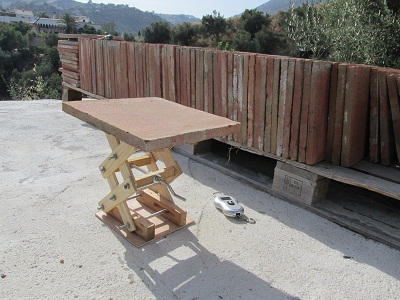
10 tiles (32kg) chooching along as if it were nothing !
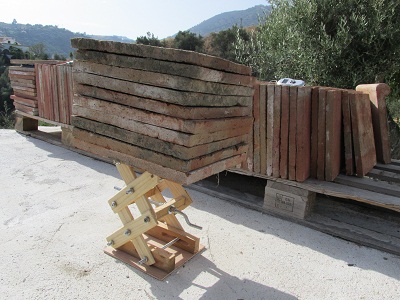
At 14 tiles (~45kg) it's creaking, and 1 more tile (48kg) it fails.
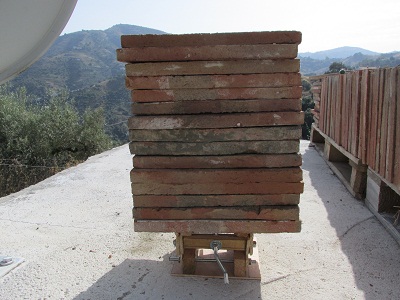 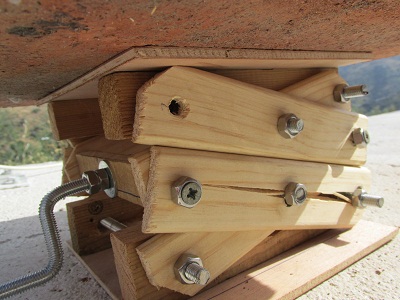
Impressive for a few bits of thin pine !
Edit:
Interesting that it failed in a way that made it collapse straight down - the 48kg stack of tiles did not topple over.
Also good that it has a pre-failure audible warning built in - it creaks !
Wood truly is an amazing material.
[Edited on 1-7-2016 by aga]
|
|
|
careysub
International Hazard
    
Posts: 1339
Registered: 4-8-2014
Location: Coastal Sage Scrub Biome
Member Is Offline
Mood: Lowest quantum state
|
|
Bold move. Destructive testing! I like it!
|
|
|
aga
Forum Drunkard
    
Posts: 7030
Registered: 25-3-2014
Member Is Offline
|
|
How else can one know the limits of a thing ?
Mash it up and measure !
So, the 'design' (such as it is) if built according to the spec detailed above, will withstand 25kg until termites eat it/it catches fire/the world
ends.
25kg is much more weight than i'd ever use in the lab.
Basically i'd use it with an oil or water bath and a hotplate, so maybe 15kg absolute max.
|
|
|
CharlieA
National Hazard
   
Posts: 645
Registered: 11-8-2015
Location: Missouri, USA
Member Is Offline
Mood: No Mood
|
|
I like this idea a lot! Your implementation is great no matter who had the idea first. The only thing that I can see your jack suffers from is the
lack of beer.
|
|
|
CharlieA
National Hazard
   
Posts: 645
Registered: 11-8-2015
Location: Missouri, USA
Member Is Offline
Mood: No Mood
|
|
Good testing aga. What do you think would happen if you substituted threaded inserts (for example "T-nuts" for the nuts that you used? I wonder if
those nuts would distribute the load over more of the wood. But you probably won't need to life 30-40kg in the lab.
(Or do you expect to raise yourself from the floor after too much spirits? )
Scratch that. It's a bad joke. I really do like your jack. -Charlie )
Scratch that. It's a bad joke. I really do like your jack. -Charlie
|
|
|
careysub
International Hazard
    
Posts: 1339
Registered: 4-8-2014
Location: Coastal Sage Scrub Biome
Member Is Offline
Mood: Lowest quantum state
|
|
I have worked with various threaded inserts and I do not much like the tee-nut.
They are only good with plywood since the prongs split regular wood something fierce.
And they don't hold well, unless you fix them with epoxy (and to do that you should make sure the threads are coated with petroleum jelly to insure no
epoxy gets on them). Without epoxy the tee-nut is only good for loads that pull the nut into the wood 100% of the time.
I think Aga's way is fine for the normal use of a lab jack where you are not putting really heavy loads on it.
If you want to beef this up, I might suggest gluing sheet steel to the outside of the wood pieces - making an ad hoc composite structure. Epoxy,
polyurethane and acrylic adhesives will all work.
[Edited on 2-7-2016 by careysub]
|
|
|
aga
Forum Drunkard
    
Posts: 7030
Registered: 25-3-2014
Member Is Offline
|
|
Seems silly gluing steel to wood - just use steel ... or wood !
[Edited on 2-7-2016 by aga]
|
|
|
careysub
International Hazard
    
Posts: 1339
Registered: 4-8-2014
Location: Coastal Sage Scrub Biome
Member Is Offline
Mood: Lowest quantum state
|
|
Quote: Originally posted by aga  | Seems silly gluing steel to wood - just use steel ... or wood !
[Edited on 2-7-2016 by aga] |
No silly in the slightest.
In fact, as someone who has some worked with this and similar techniques in making building large lightweight telescopes, and workshop structures and
had done extensive structural engineering calculations regarding this approach, I am surprised it is not more widely known or employed.
The inherent advantage of all layered composite structures (including hollow core structures like many interior doors) is that it gains most of the
advantages of a solid structure made of the surface material (usually heavier and more expensive) at a fraction of the weight and cost. This is also
why hollow structural members are commonly used.
And the reasons for this are two fold. The load on a thick structural member is born by a thin layer on the surface. And the stiffness of a structure
is proportional to the cube of its thickness. So doubling the thickness of a member increases its stiffness eight-fold. Hence hollow steel frames.
So there are enormous structural advantages to using a very stiff, very strong (usually dense and expensive) skin over a light weight core.
Why did you not make your entire jack of steel plate? Reasons (not in any particular order):
1. It is *much* more difficult to cut steel plate, typically costly tools are employed.
2. Steel plate is more expensive
3. Even allowing for the thinner members required, the steel is much heavier.
4. Availability of steel plate is much more limited.
Why not just use wood?
Well you ARE using wood! That is a large part of the point. The build is exactly the same as before.
The difference?
You are cutting cheap sheet steel with shears (cheap hand tool and very easy to do) to greatly magnify the stiffness and strength of what you actually
built. Laminating sheet steel on those scissor members makes splitting of the wood at the drill holes (the cause of failure in you overloading test) a
non issue. The steel skin distributes the load over the whole member.
Modern adhesives are a great advantage in making parts like this, although screws could be used with a lot more effort, and at the cost of not having
a flush surface, and with inferior results (discrete attachment points).
NB: I rarely make anything out a solid piece of something. I almost always make a composite structure. Plywood over foam or balsa. Carbon fiber or
fiberglass over foam, or balsa, or lightweight plywood, or other light wood. Sheet steel on wood or plywood. Etc.
[Edited on 2-7-2016 by careysub]
|
|
|
aga
Forum Drunkard
    
Posts: 7030
Registered: 25-3-2014
Member Is Offline
|
|
Ah. Now i see what you mean.
In this case, the straight strut snapped due to forces acting in the uppy-downy direction (splitty force).
A thin steel sheet glued to the strut's surface would have held the wood together under this particular strain.
Point taken.
All beer tins (here) are steel with a thin film of some plastic on the inside.
Perhaps some scissor-work to get the tin cans flat, then heating them with a blow torch whilst pressed to the wood will get them to stick.
Now there is an experiment i Can do (pun intended).
|
|
|
| Pages:
1
2 |